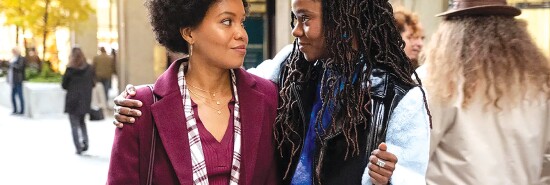
Hulu should be haunted by how good The Other Black Girl could have been
Graham Hillard
The Other Black Girl begins inside a nightmare. We know this because lights flicker eerily, an elevator opens directly into a subway car, and the train’s white passengers stare at Nella, our black protagonist, in disquieting unison. Or perhaps this last detail marks a return to waking life. After all, Nella is frequently a victim of white incivility. She works in the American book publishing industry, a noted hotbed of bigotry and hate.
I joke, of course, though one wouldn’t know it from watching Hulu’s latest. A drama-satire-thriller with racism on the brain, The Other Black Girl bends over backward to condemn prejudice despite the fact that its characters experience so little of it. The show is zippy, entertaining, excellently cast, and often great fun. It is also eye-rollingly blind to its own ideological stupidity.
Based on the novel by Zakiya Dalila Harris, The Other Black Girl stars newcomer Sinclair Daniel as Nella Rogers, an entry-level worker at swanky Wagner Books. As the series opens, Nella is reveling in a promised promotion: assistant editor rather than editorial assistant. Nevertheless, all is not well in her Manhattan office. Wagner’s top author, Colin Franklin (Brian Baumgartner), has produced a manuscript that features a “problematic” black character. Worse still, Nella is alone in her indignation, with the firm having hired no other black people since the departure of Wagner’s sole black editor some years earlier.
In its first few episodes, the series sets about correcting these problems. Temporarily emboldened, Nella gives Colin a piece of her mind and convinces her boss to commission a “sensitivity read” (i.e., a bowdlerization performed for the sake of politics). More good news arrives in the form of Hazel-May McCall (Ashleigh Murray), Wagner’s newest employee and a fellow woman of color. In an irony that at least hints at cleverness in the writers’ room, Hazel is “blacker” than Nella: Harlem to our heroine’s Connecticut, Howard University to Nella’s University of Virginia. That Hazel is alternately friendly and devious, love-bombing Nella and then setting her up to fail, merely exacerbates this tension. Is Wagner’s latest hire a long-awaited “sister” or something else altogether, something uglier?
Like Get Out (2017), Jordan Peele’s overpraised saga of racial anxiety, The Other Black Girl pairs quotidian social unease with a grab bag of horror film flourishes. Turning a hallway corner, Nella finds herself lost in an office labyrinth, no closer to her destination than when she began. Catching sight of what ought to be her reflection, she sees a stranger’s menacing face instead. The problem with these supernatural gestures is twofold. By sapping energy from the Nella-Hazel plotline, they diminish the show’s only source of meaningful political insight. Worse still, they vastly overpower the “racism” they’re meant metaphorically to represent.
Just as the rest of us do, The Other Black Girl’s creators understand that actual bigotry is vanishingly rare in the American white-collar economy. To portray Nella and Hazel as victims of authentic bias would be to sacrifice plausibility at a stroke. What the series is left with, then, are so-called microaggressions, as when one colleague spams Nella with “antiracist” agitprop or another laughs too loudly at Hazel’s culturally specific joke. It is helpful to remember, watching Hulu’s newest series, that the concept of microaggressions was popularized so that mediocrities could exercise authority over others. Case in point: A recent Slate article condemned The Other Black Girl itself for employing the “black woman hair trope.” If this is what amounts to racism in 2023, it’s hardly worth griping about.
Yet gripe Nella and Hazel do, never mind that the pair have secured two of the cushiest jobs in the history of human labor. There are other threads in the series’s tapestry, of course, chief among them a subplot concerning Kendra Rae Phillips (April Parker Jones), the previously mentioned former black editor. In the end, however, the show’s dominant mode is an us-versus-them whininess in which the crimes of “them” are never sufficiently sussed out. Throw in the series’s can-you-believe-this-nonsense ending, and one is left with a program that wastes its very real advantages chasing the same old blah-blah-blah. Racism is omnipresent, and nothing has changed. Great. May I watch football now?
CLICK HERE TO READ MORE FROM THE WASHINGTON EXAMINER
I said a moment ago that The Other Black Girl’s advantages are substantial. They are. As the ambitious, beleaguered Nella, Daniel delivers an eminently watchable performance and may well have taken a first step toward TV stardom. At 25 minutes per episode, the series scoots along as if driven by propellers and practically begs to be consumed in one or two sittings. Most importantly, the Nella-Hazel dynamic offers something rare on television: a compelling pairing that doesn’t unfold along predictable political lines. If The Other Black Girl had leaned into that tension and abandoned nearly everything else, it might have been a masterpiece.
Instead, the series is yet another unimaginative crowd-pleaser, if by “crowd,” one has in mind the self-loathing gentry liberals who decide what counts as “peak” TV. The show is not without its pleasures, to be sure. But I didn’t believe a word it said.
Graham Hillard is a Washington Examiner magazine contributing writer and editor at the James G. Martin Center for Academic Renewal.
